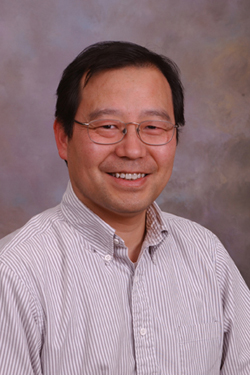Professor Jun Li
Jun Li, Ph.D. is Associate Professor, Department of Chemistry,
Kansas State University and
Associate Editor,
IEEE Transactions on Nanotechnology.
Jun is the coinventor of over 10 nanotechnology patents.
Jun’s research is in the interdisciplinary field of
nanoscience and nanotechnology with an emphasis on the development of
micro-/nano- devices for analytical, biomedical, and electronic
applications. His research covers nanomaterials growth, device
fabrication/characterization, and application development.
Nanomaterials Growth
His nanomaterials synthesis work is focused on preparing high-aspect
ratio nanowires (NWs) to achieve many one-dimensional nanoscale
materials properties. A big portion of the effort is on exploring new
methods to grow nanowires deterministically on solid substrates with
controlled diameter, length, and orientation (particularly in
free-standing vertical orientation). The nanowire materials include
carbon nanotubes (CNTs), carbon nanofibers (CNFs), semiconducting
inorganic crystalline nanowires (s-NWs), and metallic nanowires (m-NWs).
The methods include thermal chemical vapor deposition (CVD), plasma
enhanced chemical vapor deposition (PECVD), and electrochemical
deposition. Besides tuning the processing conditions, each system will
also be optimized with proper catalysts to enhance the selective growth
of specific NW materials. Substrate engineering is another route to
achieve the lattice match required for epitaxial growth of inorganic
NWs. The combination of catalysis, surface modification, and processing
optimization presents a very active ongoing research area for
nanomaterials growth.
Device Fabrication/Characterization
To characterize and make use of the intrinsic properties of individual
NWs, micro- and nanofabrication techniques have to be employed to make
connections with NWs in well-defined configurations. This becomes
exceedingly challenging due to the lack of methods to manipulate
individual nanomaterials and the presence of fundamental interface
problems at the nanoscale. The development of new integration methods
becomes the critical pathway to such device applications.
Jun employs
conventional solid-state micro-/nano- fabrication techniques including
lithography, CVD/PVD, plasma and wet chemical etching, sputtering, and
chemical mechanical polishing. In addition, nonconventional methods such
as soft-lithography, imprinting, templating, electrochemical
etching/deposition, and chemical functionalization are investigated for
various applications.
A bottom-up process has been
developed previously
to fabricate massive arrays of vertically aligned NWs, which enables the
study of individual NWs. The electronic, physical, and chemical
properties and device performance are under study with four-probe I-V
measurements, spectroscopy, electron microscopy, electrochemistry, and
scanning probe microscopy. For biomaterials and biomedical devices,
experiments involving molecular biochemistry, cell/tissue culture, and
in-vivo animal experiments are carried in our lab or in collaboration
with other partners.
Application Development
(1) Biosensors: Inlaid CNF nanoelectrode arrays are employed as
electronic sensors. The exposed tip of CNFs is selectively
functionalized with oligo- nucleotides, antibodies, or peptides for the
development of electrochemical or impedance-based sensors to detect
nucleic acids, antigens, and kinase activities. In another
configuration, the inlaid nanoelectrode array is fabricated in a
microfluidic channel as a highly effective dielectrophoresis device for
bioparticle trapping and sensing. An integrated biochip for bacteria
detection is under development in collaboration with industrial
partners.
(2) Biomedical devices: Vertically aligned CNFs are used as a
brush-like
electrode to interface with tissues. A conductive polymer coated
vertical CNF array is been explored as a multi-functional neural
electrical interface to provide topographical, mechanical, chemical, and
electrical support of neural network. Applications as other implantable
biomedical devices requiring long-term stability are under
investigation.
(3) Solid-state devices: Novel integration and fabrication
methods
are being
developed for applications of CNTs, CNFs, and inorganic NWs as on-chip
integrated circuit interconnects, thermal interface materials, and
transistors. He is currently working on the further evaluation and
optimization of both materials and processes.
(4) Energy sources: The large surface area of the 3D structure of
vertically aligned CNFs is being studied for the development of
supercapacitors and lithium ion storage. The semiconducting NW arrays
with the similar configurations are being explored for solar cell and
photodiodes, which may combine the advantages of high excitation
efficiency and high conductivity.
Jun coauthored
Preparation of Nucleic Acid
Functionalized Carbon Nanotube Arrays,
Carbon Nanotube Nanoelectrode Array
for Ultrasensitive DNA Detection,
Novel Three-Dimensional Electrodes: Electrochemical Properties of
Carbon Nanotube Ensembles,
Bottom-up approach for carbon nanotube interconnects,
Electronic properties of multiwalled carbon nanotubes in an embedded
vertical array,
Vertically Aligned Carbon Nanofiber Arrays: An Advance toward
Electrical-Neural Interfaces, and
Inlaid Multi-Walled Carbon Nanotube Nanoelectrode Arrays for
Electroanalysis.
Jun earned his B.A. in Chemistry at Wuhan University, China in 1987, his
Ph.D. in Chemistry at
Princeton University in 1995, and did his Postdoctoral Research at
Cornell University from 1994 to 1997.
He worked for Molecular Imaging Co. in scanning probe microscope
development from 1997 to 1998, and at the Institute of Materials
Research and Engineering in Singapore from 1998 to 2000. He was with the
NASA Ames Research Center from September 2000 to July 2007, during
which he led a group on nanobiotechnology research. He moved to the
Chemistry Department of Kansas State University in July 2007 to take an
associate professor position.
Read
Jacking into the Brain — Is the Brain the Ultimate Computer
Interface?





